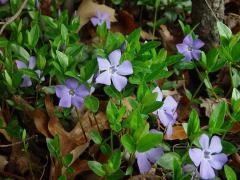Invasive Species: Vinca minor, Common Periwinkle
Common periwinkle, a common invader throughout most of the United States, is an evergreen to semievergreen trailing vine that reaches up to 6.6 ft. (2 m) in length. Vines can reach a height of 6 in. (15.2 cm). The stems are slender, somewhat woody, and green. The opposite, glossy leaves are approximately 1 in. (2.5 cm) long and narrowly elliptical. Some varieties have variegated leaf colors. Flowers are violet to blue (possibly white), 1 in. (2.5 cm) wide, and five-petaled and develop in the spring. Fruits are slender and cylindrical and about 2 in. (5 cm) long. The fruit becomes dry and splits to release three to five infertile seeds. Common periwinkle invades open to shady forests, often around former plantings at old homesites. It forms dense and extensive mats along forest floors that exclude native vegetation. It is native to Europe and was introduced in North America in the 1700s as an ornamental plant. It is still commonly sold as an ornamental ground cover.
What are invasive species, and why should we be concerned about them?
Taxonomy: Scientific and Common Names for This Species
Gentianales > Apocynaceae > Vinca minor L.
Synonym(s): lesser periwinkle, myrtle, ground myrtle
Vinca minor – USDA PLANTS Profile
Distribution Maps
common periwinkle – The reported distribution of this invasive species across the United States (Source: Invasive Plant Atlas of the United States)
Up-to-the-minute distribution maps and why they are important
Reporting This Invasive Species
What is the best way to report the occurrence of an invasive species?
How to report an invasive species sighting to EDDMapS – Early Detection & Distribution Mapping System
EDDMapS – Report an invasive species to EDDMapS.
County Extension Offices – Find your county Extension office on this map provided by USDA.
How to Identify
This invasive species can be identified by looking for the characteristics described in the paragraphs that follow.
Vine
Common periwinkle is an evergreen to semievergreen trailing vine that reaches up to 6.6 ft. (2 m) in length and 6 in. (15.2 cm) in height. The stems are slender, somewhat woody, and green.
 |
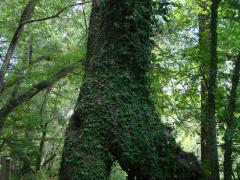 |
| Rebekah D. Wallace, University of Georgia, bugwood.org | Rebekah D. Wallace, University of Georgia, bugwood.org |
Foliage
The opposite, glossy leaves are approximately 1 in. (2.5 cm) long and narrowly elliptical. Some varieties have variegated leaf colors.
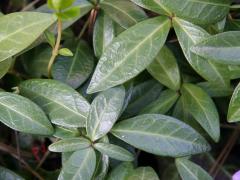 |
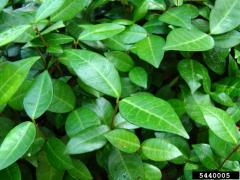 |
| Robert Vidéki, Doronicum Kft., bugwood.org | Rebekah D. Wallace, University of Georgia, bugwood.org |
Flower
Flowers are violet to blue (possibly white), 1 in. (2.5 cm) wide, and five-petaled and develop in the spring.
|
|
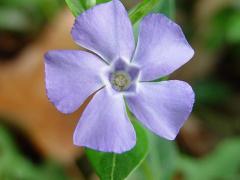 |
| Dan Tenaglia, Missouriplants.com, bugwood.org | Dan Tenaglia, Missouriplants.com, bugwood.org |
Fruit
Fruits are slender and cylindrical and about 2 in. (5 cm) long. The fruit becomes dry and splits to release three to five infertile seeds.
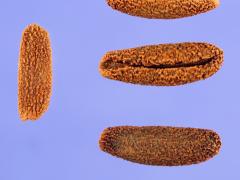 |
|
| Steve Hurst, USDA NRCS PLANTS Database, bugwood.org | bugwood.org |
Native Species That Resemble Common Periwinkle
– Images at invasive.org
| bugwood.org | bugwood.org |
– Images at invasive.org
| bugwood.org | bugwood.org |
Additional Images for Common Periwinkle
common periwinkle – Images at invasive.org
Learning Resources for Common Periwinkle
Additional Information, Biology, Control and Management Resources
Control and management recommendations vary according to individual circumstances. Location, habitat, weather, and a variety of other conditions are factors that help determine the best treatment choice. To find the safest and most effective treatment for your situation, consult your state’s land-grant institution. If you will use chemicals as part of the control process, always refer to the product label.
United States Land Grant University System – Find your Land Grant University’s College of Agriculture, University Cooperative Extension Service, or other related partner on this map provided by USDA.
Fact Sheet – Pennsylvania Department of Conservation and Natural Resources
A Field Guide for the Identification of Invasive Plants in Southern Forests – USDA Forest Service
A Management Guide for Invasive Plants of Southern Forests – USDA Forest Service
Plant Invaders of Mid-Atlantic Natural Areas – National Park Service and U.S. Fish and Wildlife Service
Weed of the Week – USDA Forest Service
Allelopathic Potential of Vinca minor – Beta Beta Beta Biological Society
Fire Effects Information System – USDA Forest Service
Invasive Plant Species Assessment Working Group (IPSAWG) – U.S. Forest Service (USFS)

